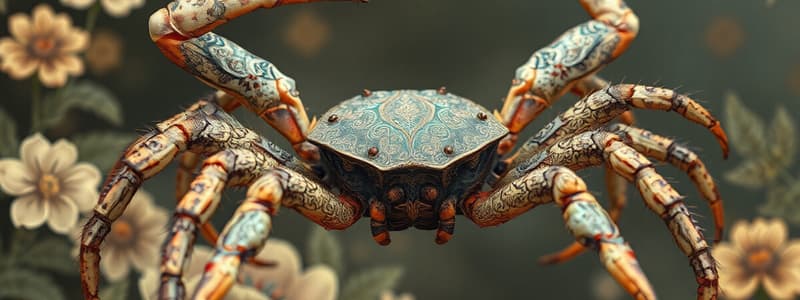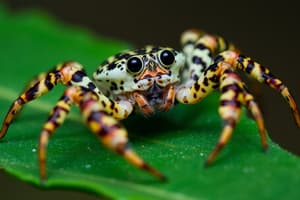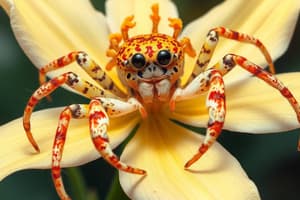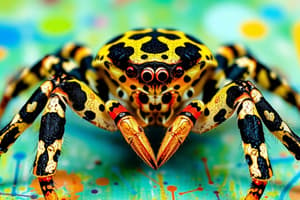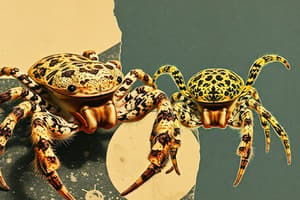Podcast
Questions and Answers
Which of the following statements best describes the hunting strategy employed by crab spiders?
Which of the following statements best describes the hunting strategy employed by crab spiders?
- They rely on camouflage and ambush tactics to catch unsuspecting prey. (correct)
- They use pheromones to attract prey, then attack when it is close enough.
- They use a web to capture prey, similar to other spider species.
- They actively chase their prey, relying on speed and agility.
What physical characteristic plays the most significant role in the crab spider's ability to capture prey?
What physical characteristic plays the most significant role in the crab spider's ability to capture prey?
- Their venomous fangs that instantly paralyze their victims.
- Their ability to change color to match their surroundings.
- Their ability to spin strong webs to trap prey.
- Their long, sweeping legs that enable them to grasp prey. (correct)
Which of the following is a challenge that crab spiders face when hunting?
Which of the following is a challenge that crab spiders face when hunting?
- Their slow movement speed, making it difficult to catch fast-flying prey. (correct)
- Their reliance on pheromones, which can attract predators as well as prey.
- Their inability to produce silk, making it difficult to build webs.
- Their limited ability to change color, making it difficult to blend in with their surroundings.
Based on the information provided, what is the primary source of food for crab spiders?
Based on the information provided, what is the primary source of food for crab spiders?
Which of the following statements accurately reflects the role of silk in the life of a crab spider?
Which of the following statements accurately reflects the role of silk in the life of a crab spider?
Flashcards
Crab Spider Hunting Technique
Crab Spider Hunting Technique
Crab spiders utilize a unique hunting strategy. They remain still, blending seamlessly with their environment, typically flowers and vegetation. Their extended legs, acting as capture tools, are used to seize prey. When prey is captured, the spider swiftly injects venom, instantly paralyzing it.
Crab Spider Habitat
Crab Spider Habitat
Crab spiders favor a lifestyle centered around flowers. They locate and make their homes amongst flower petals, often feeding on insects attracted to the nectar. Once satisfied, they simply drop their meal and continue their floral existence.
Crab Spider Camouflage
Crab Spider Camouflage
Crab spiders are masters of disguise, becoming almost invisible against their flowery surroundings. Their ability to change color to match their environment contributes significantly to their stealthy nature, making them remarkably difficult to detect.
Crab Spider Physical Traits
Crab Spider Physical Traits
Signup and view all the flashcards
Crab Spider Prey
Crab Spider Prey
Signup and view all the flashcards
Study Notes
Crab Spider Hunting Strategy
- Crab spiders remain motionless, blending into their surroundings, specifically flowers and vegetation.
- They have long, sweeping legs that they use to capture prey.
- Crab spiders bite and instantly stun their prey, effectively paralyzing them.
Crab Spider Lifestyle
- Crab spiders live and feed among flower petals.
- They drop their meals once finished.
- They are masters of stealth, often only noticed when they move to a new location.
- Their ability to change color to match their surroundings makes them incredibly difficult to spot.
Crab Spider Physical Characteristics
- Crab spiders are slow-moving, relying on their victims to come close.
- They possess long, hooked legs that allow them to seize their prey within a specific radius.
- Their silk glands are minimally used.
Crab Spider Reproduction
- Crab spiders hatch in the spring.
- They can live for the entire summer, feeding and producing eggs.
Crab Spider Prey
- Crab spiders primarily target nectar-eating insects, especially flies and bees.
- They often miss fast-flying prey.
- They are often frustrated when prey is tantalizingly close but just outside their strike zone.
Studying That Suits You
Use AI to generate personalized quizzes and flashcards to suit your learning preferences.
